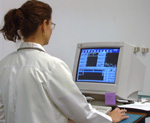Heart prevention program opens door to healthy living
by Cindy A. AbolePublic Relations
 Recovering
cardiac patients train on various exercise equipment to improve their cardiovascular
heart target rates. Exercise specialist Mark Clair helps monitor and assists
Albertha Johnson and Lawrence Demere in their weekly routines.
Recovering
cardiac patients train on various exercise equipment to improve their cardiovascular
heart target rates. Exercise specialist Mark Clair helps monitor and assists
Albertha Johnson and Lawrence Demere in their weekly routines.
Just as a car needs preventive maintenance for prolonged service, so does the human body, according to Michael E. Assey, M.D., professor of medicine, director of adult cardiac care and cath labs and director, Division of Cardiology.
Coronary heart disease continues to rank as the nation's single largest killer among men and women. In 1999, it's estimated that more than a million people will suffer from a new or recurrent heart attack. Of that number, more than one-third of these people will die.
 Nurse
Judy Vincent reviews a patient's stats on the program's telemetry monitoring
system. The computer system is used to monitor a patient's response to
exercise.
Nurse
Judy Vincent reviews a patient's stats on the program's telemetry monitoring
system. The computer system is used to monitor a patient's response to
exercise.
South Carolina ranks as the nation's leader in cardiovascular disease. Each year, it kills more than 13,000 people—more than any other disease in the state. In 1997, cardiovascular disease deaths accounted for nearly 50 percent of all deaths within Charleston, Berkeley and Dorchester counties.
With these grim statistics in hand, many physicians and specialists encourage patients to prevent their own heart disease. And cardiologists are endorsing and prescribing aggressive treatments in managing a patient's risk factors as part of their preventive treatment against heart disease.
The American Heart Association identifies specific risk factors—smoking, high cholesterol, obesity, high blood pressure, physical inactivity, stress and diabetes—as contributors to heart disease. The good news is that each of these factors can be treated or modified for at-risk individuals or cardiac patients in recovery.
But how do people know they are at-risk for heart disease?
“It's not enough to identify individuals who are at-risk for coronary heart disease,” Assey said. “Organizing effective follow-through of a patient's treatment plan is extremely important."
Today, MUSC is taking big strides in fighting South Carolina's number one killer. In May, the Division of Cardiology opened the Heart Disease Prevention Program at the Gazes Cardiac Research Institute. The program features a comprehensive cardiac care facility dedicated to the diagnosis, treatment and education of the Lowcountry community about the advantages for maintaining a healthy heart. The program provides recovery services and rehabilitation care for cardiac patients.
Staffed with a clinical nurse specialist and a team of other professionals, the program offers a multidisciplinary-phased approach that includes educational information, monitored exercise programs and nutritional guidelines for patients.
“The program really looks at people's lifestyles,” said Michelle Hendley, clinical nurse specialist, Heart Disease Prevention Program. “We're not just providing a few reading materials and sending them on their way. We specifically take the time to specialize an individual's program according to that patient's likes, dislikes and needs.”
A primary goal for the program is to reach people before they become patients. But the readiness for change is not easy. “Patients don't always respond to scare tactics,” said Hendley, who also conducts change assessments for each patient. “With prevention, we learn to take our time in discovering things about each individual. From there, we can customize a program specifically for that person. That's the beauty of a time-built trust.”
Patients are classified as primary or secondary, based upon their condition and cardiac history. The program's patient base usually comes from cardiology referrals through internists, surgeons and cardiologists.
During an initial visit, a patient undergoes a comprehensive health history, risk-assessment comparison and risk stratification. Next, a program staffer reviews any current risk factors and discusses a teaching plan and goals for follow-up care.
Hendley emphasizes the program's focus on disease prevention, rather than an alternative for medical care. It is designed to supplement a physician's role by providing resources for helping patients adapt and adjust to lifestyle changes. “It's a service for physicians,” she said. “Our goal is not to take over care.”
Other goals include organizing a full-day workshop devoted to helping patients through controllable risk factors such as smoking cessation, lipid management, exercise safety and weight control.
Hendley will also work with program director Mary B. Frankis, M.D., in planning the program's open house which is scheduled for fall 1999.
“Today, there seems to be a lot more awareness,” said Hendley, regarding patients and the availability of health resources through the Internet and other readings. “People are constantly seeking more information. As a result, they live longer and insurance programs pay fewer claims. This challenges patients to be more responsible with their health.”
Hendley worked as a clinical nurse specialist at the St. Joseph/Candler Health System's Center for Heart Disease Prevention in Savannah since 1996. The program became the model in applying an intensive interventional approach to coronary heart disease, based on management of multiple cardiovascular risk factors.
She worked under Candler medical director Neil F. Gordon, M.D., Ph.D., who worked previously at Stanford's Center for Research in Disease Prevention and at Dallas” Cooper Clinic. Hendley helped patients evaluate their risk factors and guided them in healthy programs which tackle heart disease risk factors.
“If the patients do well, its a good reflection on themselves and us,” said Hendley. “If we teach patients to do well, they set good examples for a healthy lifestyle in the community.”